The Haititan Debt, a Heavy Historical Past
The history of the haitian debt goes back to the founding of this nation which was able to win its independence from French domination in 1804. From this date and until 1825, Haiti had difficulty in getting rid of its image as a pariah state, an image foisted on them by wealthy slave-owning interests. Before the difficulty of becoming recognized as an independent state by the international community, among which many of the key players maintained their slave-holding practices, and faced by french pretentions of reclaiming under its yoke the rebel state, the Haitian governemnt had to buy its recognition by the international community.
In 1814, in order to come to terms with France’s ambitions which put pressure on the new state, Alexandre Pétion proposed for the first time, compensation in exchange for the recognition of the state’s independance. However, this proposal was stillborn. In spite of the failure of this proposal by his predecessor, Jean-Pierre Boyer reiterated the offer and after Charles X assumed power in 1824, the deal changed. Haitian independence was fully recognized by France on the condition of compensation in the amount of 150 million francs to offset the losses suffered by the former colonists, an amount which is equivalent to 400 million USD. This sum was calculated though unrigorous estimates of the values of properties owned by the former colonists based on a projection of the incomes that would have been generated by the exploitation of their properties over ten years. The sum exceded the hopes of the Haitian negociators; at the time, 150 frances represented Haiti’s total budget over ten years. Furthermore, the agreement included a clause which halved the tariffs imposed on French ships. These tariffs were the pricipal source of income for the government making the payment of the debt all the more onerous .
It is thus that Haiti was recognized as an independent state but, at what price? The largest part of the government’s resources were tapped by debt payments. Because its income relied mainly on charging tariffs, it became through the massive exportation of products such as cotton, logwood, and cacao, and above all, coffee, that the government settled its accounts. For Haitians, this became a heavy burden to bear. The woes that they suffered beore Independence, paradoxically, were followed by a debt to compensate the damages incurred by the former French colonists. On this point it may be useful to recall the calculation conducted by Hérard Dumesle, the principal opponent of Jean-Pierre Boyer regarding the issue of reparations. Dumesle established that the unpaid salaries of the workers during the time of slavery, from 1665 to 1790, was around 25 billion francs. Although this calculation was not an example of rigorous work, it evokes the absurdity of compensating the losses suffered by the exploiters following the liberation of their subjugated workers.
The payment of the colonial debt was not sound, but after many difficulties, the debt was completely absorbed in 1883. In spite of the settling of accounts, the haitian government plunged the country into a spiral of debt. Thus, in 1874, the new president, Michel Domingue borrowed 10 million francs with the intention of developing the economy of his country. Fifteen years later, President Florvil Hyppolite, following in the same spirit, contracted a debt of 50 million francs. Next, another loan was added in 1910 rasing the debt to 65 million francs. Unfortunately, these loans were not favorable for the development of the durable infrastructure of Haiti. A large part of these loans were monopolized by the payment of loans or misappropriated by the instigators of the loans.
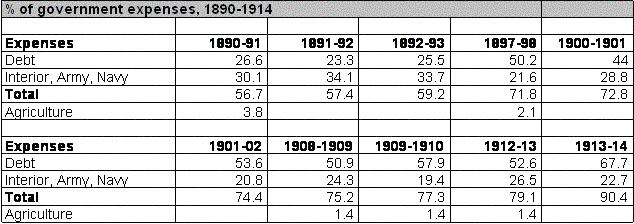
For example, on the loan of 50 million francs to Domingue, 1.5% on the total was alloted to Septimus Rameau, the vice-President for having facilitated the loan .. In brief, these loans did little for the development of Haiti and heavily monopolized the resources of the country. For example, in 1908, coffee represented 83.5% of the income generated by tariffs and of that 97.8% was allotted to paying the debt.
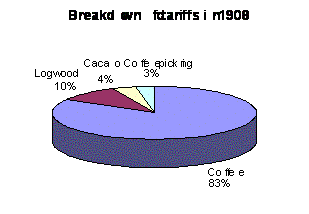
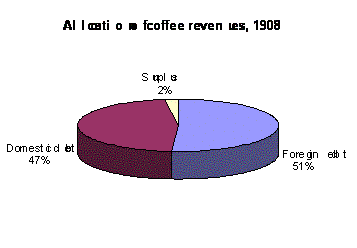
Source : G-K. GAILLARD, L’Expérience haïtienne de la dette extérieure, Maison Henri Deschamps, 1990, p.118
More recently, the Duvallier family participated in putting the country deeper in debt. Under this dicatorship, 900 million USD of public funds, comprising of loans from bilateral and multilateral creditors were routed to this infamous family. Presently, it is estimated that 40% of the haitian national debt can be attributed to this family. According to international law, this portion of the debt should not be reibursed because it was used against the public interest..
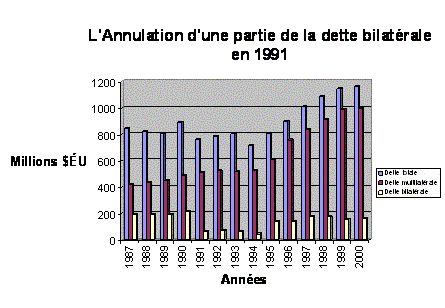
Moreover, in 1994, the bilateral creditors who allowed these loans recognized their mistakes and annulled part of the debt totalling $156 million USD : $68 million USD by France, $84 million by the United States, and $2 million USD by Canada. Nevertheless, Haiti still owes around $400 million USD in loans stemming from the loans made by the Duvallier family through mulitlateral institutions such as the World Bank and the Inter-American Development Bank. These institutions refuse to annul this odious debt that would lighten Haiti’s load.
In brief, the history of Hait’s debt reveals a scandal. From this perspective, it is worthwhile to pose the question of endemic debt in Haiti as one would for developing nations. Consequently, it is necessary to imagine the ways to loosen the grip of debt.
Debt’s vicious circle and structural adjustment programs
Throughout the 1970s, the developing nations benefited from the massive influx of capital linking loans to advantageous real interest rates of an average of -3.4% . The developing nations’ zeal to modernize becomes problematic. During this period, the long term debt of these nations increased from $62 billion USD en 1970 to $481 billion USD in 1980 and has now reached over $2000 billion USD . Similarly, Latin American debt went from 60 billion USD in the middle of the 1970s to 204 billion USD in 1980 to reach 706 billion USD in 1999 . Haitian debt reached 302 million USD in 1980 and is now at more than 1,200 billion USD. The developing nations attempted to pay off their debts by intensifying their export economy. Nevertheless, the restrictive monetary policies of the United States appeared to relieve runaway inflation and as soon as the dollar devalued immediately put an end to those plans. The result of this policy resulted in an rise in real interest rates, surpassing 19.9% in 1881 and even surpassing 27.5% in 1982 . Simultaneously, the export economy became generalized to the point at which the developing nations saw their products, mainly raw materials, pitted in intense competition that lowered their prices.
Furthermore, a large part of these loans enacted during this period were given to various governments in which corruption was the norm. On this, the IMF recognizes that half of the debt of the most endebted nations arises from capital flight and as we have seen, Haiti could not escape from this fact .
Thus, what appeared to be a promising path for the developing nations arrived at a dead end. The level of debt rose while the ability to pay shrank.
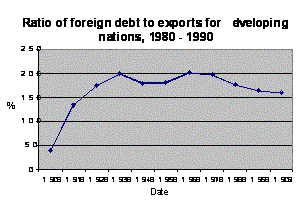
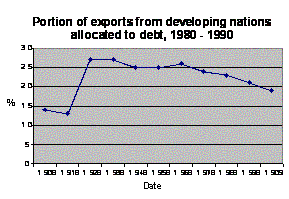
Source : M.CHOSSUDOVSKY, La mondialisation de la pauvreté, Montréal, Écosociété, 1998, p.40-41
Towards the middle of the 1980s, most multilateral loans reached their terms and the institutions in Washington demanded their payment, not allowing for a renegotiation of terms. In addition, the creditors, facing this impasse, became unwilling to grant new loans. Consequently, the developing nations were forced into a situation of last resort, that is, loans contingent on structural adjustment. From this point of view, Washington wanted to insure repayment on the loans by modifying the economic systems of developing nations. Beyond simple macroeconomic modifications, the structural adjustment programs on which new loans were contingent struck at the heart of governmental policies against the will of the people. Thus, measures preceived as necessary for a healthy economy for the short term were enacted, such as : dollarization, freezing of the printing of money, the deregulation of wages, austerity measures, and for the long term : the deregularization of commerce, the privatization of State-owned companies, financial reforms, etc. In brief, the developing nations saw themselved subjected by economic paractices decided upon from outside their borders, resulting in a loss of sovereignty arising from endemic debt.
Haiti did not escape the watchful eye of the IMF. Since 1996, the loans granted by this institution were subject to a mandate from which flow a series of recommendations. If the government does not act in good faith, the loans can stop at any moment. It is in this vein that the employees of the IMF suggested to the Haitian government to reduce its resources attributed to goods and services from 3% (schedule 2000/2001) to 2% of the GDP and to increase those available for monetary policies, expecially to fight inflation. Also, it was suggested that the Banqu national de Crédite and state-owned companies such as, the electric company of Haiti, the airport, ports, the telephone company, and the aquaduct company, parivatize. By contrast, representatives seem to rent their policies for commercial exchanges, Haiti being on of the most open countries in the Western Hemisphere ..
Haiti needs to have its debt annulled because :
– Approximately 40% of the debt was contracted during the Duvalier regimes. This is a contemptible debt since a large part of it was misappropriated and the funds were not used for the public interest.
– Le retour des biens des fonds détournés et la chasse des biens mal acquis en particulier pour la période 1957-2001
– Haiti is the poorest country in the Americas and is one of the poorest of the developing nations.
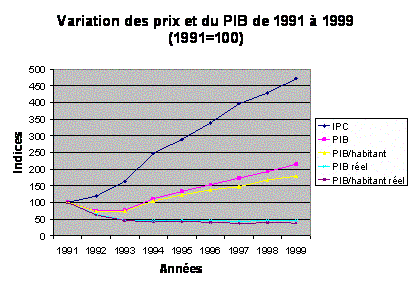
Source : BRH, Rapport annuel 1991
The per capita GDP is only 500 USD. Furthermore, the increase in the index of price to consumption is higher than the per capita income. Consequently, the per capita GDP is in decline. In order to reach internationally recognized objectives for development by 2015, haiti must have its debt annulled end must have an increase in development aid.
– Haiti places in 152th place out 175 in the index for human development. Life expectancy at birth is fifty-eight years. The rate of illiteracy for adults is over fifty per cent end the unemployment rate is seventy per cent.
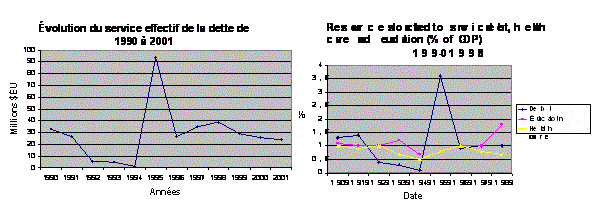
– Paying the debt monopolizes as many resources as education or health, services that are critical for the improvement of quality of life in Haiti.
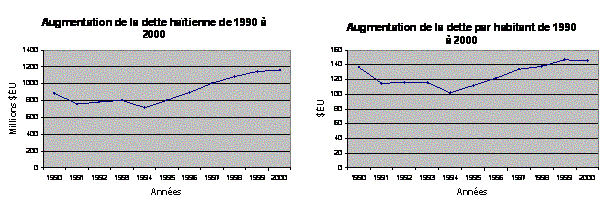
– Haiti’s debt has increased exponentially. Seventy per cent of it has been acquired between 1995 and 2000.
Other scenarios for servicing the debt
The cancelling of the debt is not a new idea. Since World War II, three debt cancellations constitute examples of what the international community has deemed reasonable.
– In 1946, Peru declared that it would not set aside more than 3.5 percent of its revenue towards paying its debt. This policy was accepted in the following decade by all of its main creditors.
– After the end of World War I, Germany was forced to pay reparations to the victorius powers. The debt was of such a magnitude that it was judged as one of the main causes of World War II. From 1925 to 1928, the payments for reparations amounted to thirteen per cent of its exports and then fifteen per cent from 1929 to 1031 (fifteen per cent is considered sustainable according to the Heavily Indebted Poor Countries Initiative). In 1953, it was agreed that part of the German debt should be cancelled, considering that Germany should be reconstructed before it could actually pay its debt. Paying the debt would not be put in effect so long as there wa no trade surplus. Keeping in mind the problems of the 1920s, payment of debt was lowered to three per cent of exports, 0.4% of the GDP, and two per cent of national revenues.
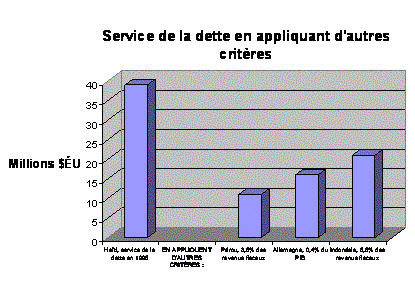
– To compensate the overthrow of Sukarno, Suharto obtained an important cancellation of his country’s debt in 1979. The payment of debt was settled at six per cent of exports, 0.7 per cent of its GDP and 6.5 per cent of the national revenues.
Those criteria were retained when the development of the concerned countries was taken into account.Here is what these scenarios yield when applied to Haiti.
Other ways of looking at servicing debt
Access to health care and education is a basic human right. The community of donors and creditors has subscribed to the goals of the Development Assistance Committee of the Organization of Economic Cooperation for the year 2015. Based on the calculations of UNCTAD and the UNDP we have stimated that the sum of the fiscal revenue that a nation may expect to collect and the sum of essential costs that the government must incur if it hopes to meet the goals set forth by the DAC for 2015 . If we accept that the State must reserve its revenues and international aid for essential spending and use that which remains for the service of the debt, Haiti could not set aside anything for its debt and would still have a deficit of 53 million USD.
The international financiers’ opinion
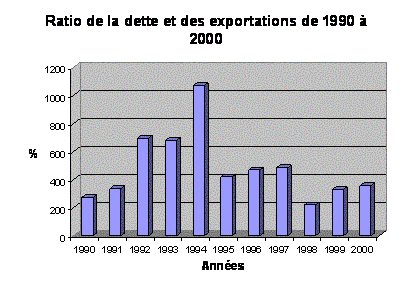
Haiti is not included among the Heavily Indebted Poor Countries (HIPC), which is necessary for it to be considered for debt cancellation according to the criteria set forth by international financial institutions. Nevertheless, Haiti has a debt burden that is clearly unsustainable according to the World Bank which is set at 150 per cent of a nation’s exports. Meanwhile the World Bank pretends that the international aid that Haiti recieves renders its debt sustainable. Furthermore, the World Bank is not convinced of the stability of Haiti’s institutions and their complicity in accepting programs for economic reform ..
Jubilé 2000 Campaign in Haiti
Jubilé 2000 Haïti was founded in October 1998. It is a coalition of religious, political, financial, and other non-governmental organizations under the auspices of the Plateforme Haïtienne Plaidoyer pour un Développement Alternatif (PAPDA). Since, Jubilé 2000 Haïti has sought to educate and mobilize the population against the yoke of debt. On June 29, 1999 activists organized a march agains the Inter-American Development Bank in Port-au-Prince and stated to the press that, « The Haitian people has not benited from the money that you have loaned, and we do not approve of repaying the debt so long as we live in misery ». On July 6, Jubilé 2000 Haïti had a sit-in in front of the USAID building, demanding the cancellation of the debt. In December 1999, the National Coalition of Jubilé 2000 Haïti met with the President of the Republic, Mr. René Garcia Préval. On January 22, 200, Jubilé 2000 Haïti organized a national Day against Foreign Debt with a telethon and demonstrations outside of television studios. The goal was to inform the population on the different aspects of the debt, to pressure financial institutions, and demand that the government make its foreign financial contracts trasnparent. In June 2000, the Coalition met with the President for the second time. In January 2001, the IMF agreed to lower the Haitian debt, if the country accepts cetain structural adjustment programs. Until now these promises have yet to be fulfilled.
What can we do ?
– Write a letter to Haiti’s principal creditors (the US, the World Bank, the IMF, the IADB, the International Bank for Reconstruction and Development, demanding the cancellation of this unpayable debt.
– Send a copy of this letter to the Haitian Embassy. Mention that you support the cancellation of this debt and that you support the Haitian campaign to allocate the funds generated from the cancellation of the debt to poverty reduction programs.
– Get in contact with the Haitian community in your area to organize an event around Haiti and decide how to support the Haiti campaign.
– Create ties with a Haitian community with which you can work to advance the initiatives of the campaign (contact Jubilé 2000).
– Launch a campaign for the return of misappropriated funds to Haiti.
– Become a coordinator for the Haiti campaign. For more information visit http://www.jubile2000uk.org
Key points for your letter :
– Haiti had to pay for its independence, paying reparations to former slave owners.
– Almost half of the debt was accrued during the Duvalier dictatorship.
– Haiti is the poorest country in the Americas.
– Haiti is a country in which the total ratio of debt to exports is over 150 per cent, which has been deemed to be the limit of sustainability by the IMF and the World Bank.
– The indices of poverty and development indicate that the Haitian people need the cancellation of the debt : more than eighty per cent of the rural population of Haiti live below the poverty line; the adult illiteract rate is over fifty per cent and the infant mortality rate is twice the average for Latin America and the Caribbean.
June 2002
Jubilee 2000 Haiti
Jean-Pierre Ricot, Coordinator
Document produced by Eric Duhaime
World Bank :
Mr James Wolfensonh,
President of the World Bank,
1818 H Street, NW,
Washington DC, 20433, USA
The United States of America:
Mr Georges W Bush,
President of the United States,
The White House,
Washington DC, 20500, USA
International Monetary Fund :
The Managing Director of the IMF,
H Street NW,
Washington DC, 20009, USA
France :
Mr Jacques Chirac,
Président de la République,
Palais de l’Élysée,
55 rue Faubourg rue Saint-Honore,
7500S, Paris
Inter-american Development Bank :
Mr. Enrique Iglesias,
President of the Inter American Development Bank,
1300 New York, Avenue NW,
Washington